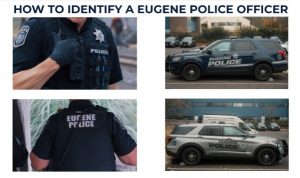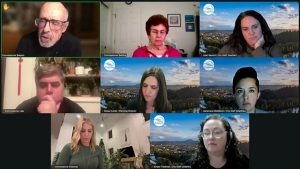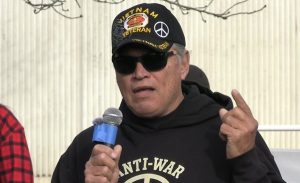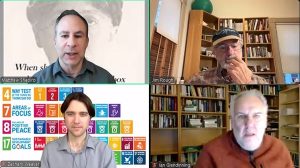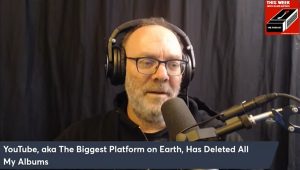Public Health Reserve Corps celebrates 1st year
12 min read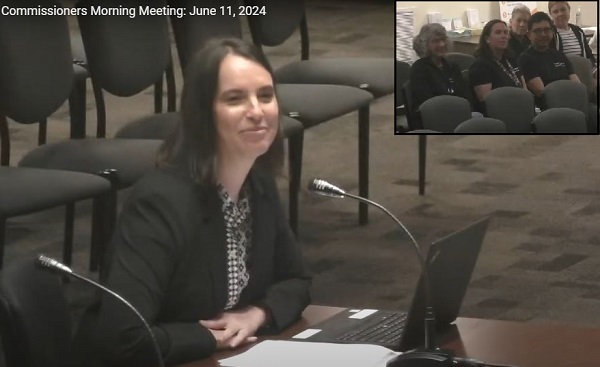
Lane County celebrates the one-year anniversary of its Public Health Reserve Corps. With the Lane County commissioners on June 11:
Brian Johnson (Lane County Public Health): Brian Johnson, I’m the Healthy Communities unit manager for Lane County Public Health and this morning, we’re here really to celebrate the one-year anniversary of the Public Health Reserve Corps, which has been in effect in Lane County a very short amount of time, but it’s been a wonderful achievement. And I’ll just put a little context on that.
[00:00:25] I’ve been with the county for about 15 years. During that time I was one of our public health preparedness coordinators, and at the time, we were introduced to the idea of the Public Health Reserve Corps when I first started. And it had been in discussion at least five years prior to that. So two decades of discussion have now moved forward into an effective launch of that Public Health Reserve Corps.
[00:00:46] You know, during COVID, we were one of the largest counties in the state of Oregon that did not have a Public Health Reserve Corps during that time. But that’s not to say we didn’t have a very strong volunteer response. We had over 500 volunteers or more who had connected and made us successful during that time and we really saw the value in bringing and formalizing a Public Health Reserve Corps locally and making this happen.
[00:01:06] I’m going to transition over to Sarah Swofford who’s the supervisor of the Public Health Reserve Corps and again, just acknowledging this successful one-year anniversary date, and Sarah’s really been the champion to bring that forward.
[00:01:22] Sarah Swofford (Lane County Public Health Reserve Corps): The Lane County Public Health Reserve Corps was officially approved by the federal government as a medical reserve corps in April of 2023. Lane County received two years of funding for two full-time positions, a supervisor (which is me) and a coordinator, who is Cayetana Gomez de Soler, who’s back here, along with some of our volunteers here today, through the MRC STTRONG (Medical Reserve Corps State, Territory and Tribal Nations, Representative Organizations for Next Generation) grant. And so our funding runs through July of 2025.
[00:01:48] We onboarded our very first volunteer in September of 2023, who is also here today, Dr. Fran Munkenbeck is back there. And since then, we’ve onboarded, I believe this week, it’s a total of 13 volunteers.
[00:02:04] We’ve developed strong relationships with local and state partners and have started a robust ‘blue skies’ emergency preparedness education program for the county’s most disaster vulnerable populations.
[00:02:15] The LCPHRC has had two official activations: We did three days of clean and cool air respite sheltering support during the Lookout and Bedrock fires in August of 2023, which was a governor-declared emergency; and four days providing medical triage in the Red Cross shelter at the Cottage Grove Community Center and supporting food distribution and community support efforts at the Springfield Community Resource Center during the federally-declared winter storm disaster in January of 2024.
[00:02:47] Currently we are also activated to support communicable disease in public health during the current pertussis outbreak. So when communicable disease nurses are overburdened and cannot respond to all of the pertussis cases, our volunteers provide backup to call in prophylaxis.
[00:03:07] The PHRC has worked closely with Lane County Search and Rescue, Eugene Springfield Fire, Plaza de la Comunidad, Escudo Latino, Arc of Lane County, HEARTsafe program at PeaceHealth, the State Network of Medical Reserve Corps, Oregon Health Authority’s state emergency registry of volunteers, which we call SERV-OR, Lane County Emergency Management, and Community Organizations Active in Disaster, just to name a few.
[00:03:33] We’ve trained SAR and Oregon MRC leadership network on culturally responsive emergency response and volunteerism and presented on health equity alongside the Vermont State MRC and St. Louis County MRC in Chicago at the MRC national conference back in May, last month.
[00:03:52] We hold monthly drills for our volunteers and so we have exercised all kinds of different skill sets including radio use protocols, incident command system, medical search support, cultural responsiveness, medical scenarios, and triage after a catastrophic earthquake.
[00:04:09] We are currently setting up to do our largest exercise to date and we’re hoping to do it at the end of July, before, hopefully, our wildfire season is in effect.
[00:04:19] Our unit has developed curricula in Spanish for Hands-Only CPR, cultural responsiveness, and we’ve worked with the county’s health officer to complete emergency medical protocols that can be followed during activations. And we used as our model Eugene Springfield Fire’s medical protocols and procedures, so that if we are ever called to support them as backup, we will be in alignment with the protocols that they use.
[00:04:46] The PHRC has also been working to develop our standards of operations guidelines, protocols. As you can imagine, developing a new program has a lot of that type of work involved.
[00:04:56] Our non-emergency activities have been a success we’re proud of, and continue to grow. We’ve so far trained 117 people from underserved communities in Hands-Only CPR since August during four community-based events. These have been held at the Cottage Grove Community Center and with Arc of Lane County at our facility here at the Health and Human Services Building, as well as their facility.
[00:05:19] Trainings have included also Narcan training in collaboration with our public health prevention program. Two of the trainings have been conducted in Spanish, and our partners have included Plaza de la Comunidad, Arc of Lane County, and Escudo Latino.
[00:05:33] So we’ve created kind of a consortium where monthly they sign people up who are interested in having these trainings. And the reason that we focus on our Spanish-speaking populations is the American Heart Association consolidated hospital data across the whole country and was able to show that our communities of color are 20% – 40% less likely to receive CPR than white community members based on bias, but also the lack of training among their own families and friends, and especially outside of a clinical setting.
[00:06:05] And so that is a barrier that we’re working in collaboration with the HEARTsafe program with PeaceHealth. And we are the primary partner that is doing Spanish language Hands-Only CPR trainings.
[00:06:16] I don’t know if you’ve ever gone through the CPR training, but it’s four hours, it costs $100, and not everyone can afford it. It’s a huge barrier. We’re actually looking at some ways that even for our own volunteers we could provide that for free. And so often it’s a necessity even for applying for jobs.
[00:06:34] And Hands-Only CPR focuses just on recognizing signs of cardiac arrest and understanding how to give quality compressions, which can absolutely save a life, and they do. Because we know that the more time that you have without compressions, the less oxygen reaches the brain, which means that you know, someone can actually survive seven to 10 minutes if they’re having quality compressions, whereas if there’s no blood circulating with oxygen to the brain, then the outcomes are much worse. And so, it’s not with the breaths and the full training, it is just quality compressions.
[00:07:12] How to use an AED: We have practice AEDs because those are pretty intimidating. Also, we’re focusing on Spanish speakers. So how do they, do all AEDs have Spanish? What does it sound like in English? How do you call 911? Currently, there are interpretation services with our 911 services, but I believe we don’t have Spanish-speaking 911 operators. And so also even coaching on how to share what’s going on where you are, things like that. So really reducing those barriers.
[00:07:44] A training that we held at one of the largest farms in the county saved a life the same week that we held the training. There was a farm worker who attended the training and recognized that they were having symptoms of possible cardiac issues, went immediately to their doctor, and was sent in for an emergency lifesaving bypass. So we were really excited that we had that kind of success and were able to show that we’re making an impact.
[00:08:07] The more trainings that we do, the more requests we receive for additional trainings, and an expansion of topics, to include general family emergency preparedness. Our focus for what we call our ‘blue skies activities’ is to serve and reach those who are most vulnerable during disasters and emergencies. And all of those served thus far have been from these populations.
[00:08:29] We also plan to expand our train the responder efforts, serving diverse community members in respectful and affirming ways.
[00:08:37] We’re working with Behavioral Health to develop a capacity-building training on best practices to serve people experiencing intellectual and developmental disabilities. We offer these trainings to other responder agencies when they request them, such as SAR (Search And Rescue) or Eugene Springfield Fire.
[00:08:53] Another success is the recognition our program has been receiving. The LCPHRC was nominated by the Conference of Local Health Officials Emergency Preparedness and Response Awards Committee (that’s a mouthful) for the Public Health Emergency Preparedness and Response Exceptional Group Achievement or Partner Award.
[00:09:12] We were featured in the main newsletter of the National Association of County and City Health Officials (that’s NACCHO, not ‘nacho’) for our winter storm response. And finally, KLCC did a feature on our Hands-Only CPR work just a couple of weeks ago.
[00:09:29] Amidst these successes, we do face barriers. We along with the department leadership and county council continue to navigate administrative hurdles to build a structure for this program in a county system that has never housed a volunteer program such as ours.
[00:09:46] We’re also seeking external funding for our two-person staff team as well as for the supplies and training expenses that we need as we continue to expand our efforts.
[00:09:57] The Public Health Reserve Corps has been welcomed into the emergency preparedness efforts of our county partners and emergency management. We’re learning to work closely with these partners and are integrating our efforts into the plans, procedures, and meetings that exist to kind of set us up in terms of our emergency support functions and how we can support those.
[00:10:17] These collaborations have been extremely positive and supportive and help guide our programmatic development to be ready to respond when Lane County needs us and build Lane County’s resilience from the ground up when we are not responding to emergencies.
[00:10:30] And I was wondering if I could have a moment to introduce our volunteers, is that okay? Thank you so much. So from left: We have Dr. Munkenbeck, who was our first PHRC volunteer; next to her is Cayetana Gomez de Soler, who is the coordinator and heart of our program; then we have Eduardo Tapia, who is a double award-winner because he volunteers for both Search and Rescue and for PHRC; and Connie Sullivan, who used to work for the county in public health before she retired, and she’s devoted a lot of time to supporting our efforts throughout COVID and now with the PHRC.
[00:11:09] Commissioner Heather Buch: I sincerely want to thank all the volunteers of your team. We know that you could be doing anything else with your time and making this a priority for your community is just really heartwarming and I know that the people that you serve really feel the impact and I couldn’t be more thankful for you being willing to step up.
[00:11:33] Commissioner Ryan Ceniga: What a great presentation. Thank you, that’s an awesome program.
[00:11:39] Commissioner David Loveall: I mean, you got 117 people and 13 volunteers. you guys are herding some serious cats here, right? And it’s really great too that you also have the esprit de corps, if you will, that when you know you have those volunteers, you treat them right, you recognize and acknowledge them, so I appreciate the fact that you create that esprit de corps in your community of people that serve, and it’s only going to make the community better, So, good job.
[00:12:02] Commissioner Pat Farr: You know, I listen to KLCC, and there was the article back in May and there are some great quotes in there about how deep your training goes into the community. And it’s just providing skills to people who are able to use them on a moment’s notice, and that there’s the one description of the young girl who saved her dog from choking after learning the skills in a CPR class, which you mentioned the expense of a CPR class, which you provide for free and are able to change lives, touch lives, and that’s what it’s all about, isn’t it? Touching lives and making certain that people are able to, that people are better equipped to be resilient and to live comfortably and safely inside our community.
[00:12:42] So bravo, thank you so much. and thank you to the volunteers for the time that you put in and the driving this effort forward. We have a website that you’re featured on and it goes into the national program and how you’re following the national program. And I think as the years move forward we’ll hear more and more from you about the effectiveness and the depth you’re reaching in the community with the volunteers, so it’s pretty remarkable. I sit here in awe of the work you’re doing. Thank you.
[00:13:11] Commissioner Laurie Trieger: So, this is really exciting. Congratulations on one year. I can’t wait for the three-year or the five-year because I’m sure it’s going to be one of those cumulative compounding success stories.
As Commissioner Buch said, volunteers could be volunteering on anything or doing anything with their time, but creating a program creates sort of an identity that people say, ‘I am a member of this volunteer corps,’ and that’s really different and really efficient as far as keeping people engaged and ready to activate, versus sort of one-offs and having to start over each emergency with finding people and bringing them in.
So I’m very excited to see how this program grows and how many more people we engage—both sort of lay people that get trained to do things they didn’t already know and professionals who can bring their professional skills and expertise or professionals in one area who want to do something different during their volunteer time than what they do as professionals—and there’s a place for all of that.
[00:14:08] I know other people here remember Liz Runte, who was the volunteer manager at United Way for a long, long time. When we did Project Homeless Connect—you might remember her, Commissioner Farr, she was there—and she taught me the greatest saying about volunteerism, which is: ‘Volunteer is a pay scale, not a job description.’ Because people have in their minds, like, ‘Oh, we use volunteers for things like envelope stuffing.’ Well, you do, but it might be a physician stuffing envelopes because they’ve been, right? Or it might be a physician doing medical care on a volunteer basis, right?
So I really, I just see this as a program where there’s sort of room for everybody and it’s just going to really benefit the community, so thank you .
[00:14:48] Sarah Swofford (Lane County Public Health Reserve Corps): Thank you. That’s actually one of the reasons that we chose to call ourselves ‘Public Health Reserve Corps,’ in addition to being located within Public Health, is just trying to show that we really almost need more non-medical volunteers than we do medical volunteers, which was a huge lesson from COVID. You need people to be a site lead, organize, liaise, logistics, traffic control, bring patients through.
[00:15:11] And there have been a lot of challenges in building a brand-new program. But I would say one of the benefits that I have seen for us is that we also get the opportunity to be really volunteer-led. And so they’re our leaders and we are here to support them. And so if they have an interest in doing an activity in a certain population or a certain location, we’re really there to support that. For example, the presentation that we did at the farm was, one of our volunteers works there and it’s like, we really need to work with this community.
[00:15:41] John Q: Lane County’s Public Health Reserve Corps celebrates its one-year anniversary. They are currently activated to help with the outbreak of whooping cough. To learn more about their training programs, and to join the Corps, see the Lane County website.
